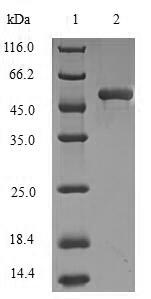The expression region of this recombinant Human DCTN1 covers amino acids 213-547. The expected molecular weight for the DCTN1 protein is calculated to be 55.2 kDa. This DCTN1 protein is produced using e.coli expression system. Fusion of the N-terminal 6xHis-SUMO tag into the DCTN1 encoding gene fragment was conducted, allowing for easier detection and purification of the DCTN1 protein in subsequent stages.
The human dynactin subunit 1 (DCTN1) protein is a key component of the dynactin complex, crucial for intracellular cargo transport along microtubules. DCTN1 facilitates dynein motor function, contributing to retrograde axonal transport and organelle positioning. In neurobiology, DCTN1 is linked to neurodegenerative diseases, including Perry syndrome. Research on DCTN1 provides insights into molecular mechanisms governing cellular trafficking and neuronal health. Dysregulation of DCTN1 is associated with pathogenic conditions, making it a focus in neurodegenerative disorder investigations. Understanding DCTN1's functions offers potential for therapeutic strategies targeting transport-related disorders and enhances knowledge of cellular processes in neurology and related fields.




